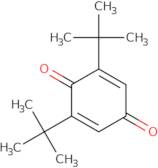
2,6-Di-tert-butylcyclohexa-2,5-diene-1,4-dione
CAS: 719-22-2
Rif. 3D-FD33565
| 25g | 172,00 € | ||
| 50g | 248,00 € | ||
| 100g | 364,00 € | ||
| 250g | 517,00 € | ||
| 500g | 740,00 € |
Informazioni sul prodotto
- 2,5-Cyclohexadiene-1,4-dione, 2,6-bis(1,1-dimethylethyl)-
- 2,6-Bis(1,1-dimethylethyl)-2,5-cyclohexadiene-1,4-dione
- 2,6-Bis[1,1-dimethyl ethyl]quinone
- 2,6-Di-Tert-Butyl-P-Benzoquinon
- 2,6-Di-Tert-Butylcyclohexa-2,5-Diene-1,4-Dione
- 2,6-Di-tert-butyl-1,4-benzoquinone
- 2,6-Di-tert-butyl-2,5-cyclohexadien-1,4-dione
- 2,6-Di-tert-butyl-2,5-cyclohexadiene-1,4-dione
- 2,6-Di-tert-butyl-p-quinone
- 2,6-Di-tert-butylbenzoquinone
- Vedi altri sinonimi
- 2,6-Di-tert-butylquinone
- 2,6-Ditert-butylcyclohexa-2,5-diene-1,4-dione
- 3,5-Di-tert-butyl-p-benzoquinone
- 3,5-Di-tert-butylquinone
- Dibutylpbenzoquinone
- NSC 14448
- p-Benzoquinone, 2,6-di-tert-butyl-
2,6-Di-tert-butylcyclohexa-2,5-diene-1,4-dione (BHT) is a chemical compound that is used as an oxygenation catalyst and analytical method. The molecular structure of BHT contains a hydroxyl group with a redox potential of 0.3 V and a thermal expansion coefficient of 7 x 10 K. This compound has been shown to be toxic in mice, causing lung damage and oxidative DNA damage. BHT also inhibits the transcriptional regulation of genes by binding to amines in the cell membrane. It can act as an antioxidant because it binds to reactive oxygen species and prevents them from oxidizing other molecules in the cell. These properties make it useful for protecting cells from oxidative stress caused by reactive oxygen species or peroxides.
Proprietà chimiche
Richiesta tecnica su: 3D-FD33565 2,6-Di-tert-butylcyclohexa-2,5-diene-1,4-dione
Se si desidera richiedere un preventivo o effettuare un ordine, si prega invece di aggiungere i prodotti desiderati al carrello e poi richiedere un preventivo o un ordine dal carrello. È più veloce, più economico, e potrà beneficiare degli sconti disponibili e di altri vantaggi.





